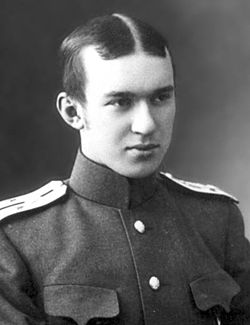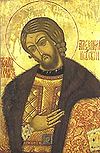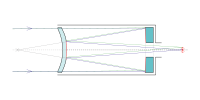- Dmitry Dmitrievich Maksutov
-
Dmitri Dmitrievich Maksutov 
Dmitry Dmitrievich Maksutov (Russian: Дми́трий Дми́триевич Максу́тов) (23 April [O.S. 11 April] 1896 - 12 August 1964) was a Russian / Soviet optical engineer and amateur astronomer. He is best known as the inventor of the Maksutov telescope.
Contents
Biography
Dmitry Dmitriyevich Maksutov was born in 1897 in either Nikolayev[1] (aka Mykolayiv, Ukraine)[1] or the port city of Odessa, both in what was at the time part of the Russian Empire.[1][2] His father, a naval officer serving with the Black Sea Fleet, came from a family with a long and distinguished naval tradition. His great-grandfather, Peter Ivanovich Maksutov, was given the title of prince, thereby raising the family to hereditary nobility as a reward for bravery in combat. His grandfather, Dmitri Petrovich Maksutov, was the last Russian governor of Russian-American Alaska, before it was purchased by the United States in 1867.
Dmitri became interested in astronomy in early childhood, and constructed his first telescope (a 7.2-inch/180mm reflector) when he was twelve years old. Later he read publications by the famous Russian optician Alexander Andreevich Chikin (1865–1924), who became his teacher. He constructed a much better 10-inch (210mm) reflector and began serious astronomical observation. At 15 years of age he had already been accepted as a member of the Russian Astronomical Society. Three years later he graduated from the Military Nikolayev Engineering Institute in what was then Petrograd (aka Saint Petersburg, Russia), now Military engineering-technical university. Between 1921 and 1930 he worked at the Physics Institute of the University of Odessa in the field of astronomical optics.
In 1930 Maksutov established the Laboratory of Astronomical Optics at the State Optical Institute of Leningrad and led it until 1952. This laboratory was one of the leading astronomical research groups in the USSR. While there he published Анаберрационные отражающие поверхности и системы и новые способы их испытания [Aberration-free reflective surfaces and systems and new methods of testing them] (1932), in which he analyzed aplanatic double mirror systems and introduced the compensating method, which he proposed as early as 1924. This became the main control method of mirror study along with the shadow method. In 1944 he became a professor as a result of his famous paper, and from 1946 a Corresponding Member of the USSR Academy of Sciences. From 1952 he worked in Pulkovo Observatory. Maksutov died in what was then Leningrad (aka St. Petersburg) in 1964.[2]
Inventions
Maksutov's most well known contribution in the field of optics was made in 1941, when he invented the Maksutov telescope. Like the Schmidt telescope, the Maksutov corrects for spherical aberration by placing a corrector lens in front of the primary mirror. However, where the Schmidt uses an aspheric corrector at the entrance pupil, Maksutov's telescope uses a deeply curved full diameter negative meniscus lens (a "meniscus corrector shell"). Dmitri published the design in 1944 in a paper entitled "Новые катадиоптрические менисковые системы" [New catadioptric meniscus systems].[3] This method was adopted not only by his own laboratory for many of the most important observatories in the Soviet Union, but also internationally. Several commercial telescope-making companies produce Maksutovs, including Celestron, Meade, and Questar.
He created many objective lenses, mirrors, and prisms of various sizes and purposes. He also created a photo-gastrograph (used for photographing the stomach), a needle-microscope, shadow instruments for aerodynamic tubes, telescopic spectacles, and other instruments.
Awards
- Stalin Prize (1941, 1946)
- two Orders of Lenin (1945,1958)
- Order The Badge of Honour (1943)
- Grand Prix at the Expo '58 in Brussels
See also
External links
- Biography - on the website of Vavilov State Optical Institute
- Dmitri Maksutov: The Man and His Telescopes
References
- ^ a b c http://www.springerlink.com/content/k7j14v2117168489/ The Biographical Encyclopedia of Astronomers 2007, Part 13, 730-731, DOI: 10.1007/978-0-387-30400-7_892, Maksutov, Dmitry Dmitrievich, by Alexander A. Gurshtein
- ^ a b Reflecting Telescope Optics, By Ray N. Wilson, page 498. Google Books, pg 498
- ^ Dmitri Maksutov: The Man and His Telescopes by Eduard Trigubov and Yuri Petrunin.
People from Russia Leaders and religious - Pre-1168
- 1168–1917
- 1922–1991
- 1991–present
- RSFSR leaders
- General secretaries
- Soviet premiers (1st deputies)
- Soviet heads of state (and their spouses)
- Prime ministers (1st deputies)
- Foreign ministers
- Prosecutors general
- Metropolitans and patriarchs
- Saints

Military and explorers - Field marshals
- Soviet marshals
- Admirals
- Aviators
- Cosmonauts
Scientists and inventors - Aerospace engineers
- Astronomers and astrophysicists
- Biologists
- Chemists
- Earth scientists
- Electrical engineers
- IT developers
- Linguists and philologists
- Mathematicians
- Naval engineers
- Physicians and psychologists
- Physicists
- Weaponry makers
Artists and writers Sportspeople - Chess players
Categories:- 1896 births
- 1964 deaths
- Russian astronomers
- Russian scientists
- Soviet astronomers
- 20th-century astronomers
- Opticians
- Stalin Prize winners
- Recipients of the Order of Lenin
- Russian inventors
- Optical engineers
Wikimedia Foundation. 2010.

